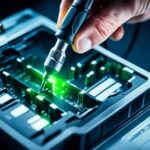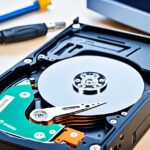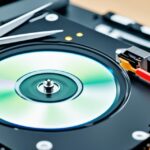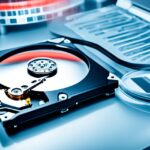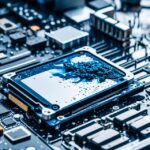Table of Contents
Encountering the “A Device Which Does Not Exist Was Specified” SSD error can be quite annoying. This problem usually happens because of issues like bad connections, not having the right permissions, or the computer getting drive letters mixed up. Luckily, you can solve these SSD errors and get back to your files. In this article, we’re going to explain why this happens. We’ll also show you how to fix it1.
Key Takeaways
- The SSD error indicates issues like improper connections or lack of permissions.
- Common causes include mismatched drive letters and outdated drivers.
- Methods to fix this error consist of reconnecting the SSD and updating driver software.
- Recourse tools like EaseUS Partition Master can assist in managing drive letters and partitions.
- Taking preventative measures is essential to avoid future SSD errors.
Understanding the “A Device Which Does Not Exist Was Specified” SSD Error
The “A Device Which Does Not Exist Was Specified” SSD error is really annoying for people trying to get to their files. It usually means there are some issues with how the drive is connected, the permissions it has, or some problems within the operating system itself. Getting what this SSD error means is key for sorting it out properly.
This error could pop up for a few reasons, like if the connection isn’t right, the drivers are old, or the SSD itself is damaged. When this happens, users might not be able to open their devices. This could lead to losing important data. Getting to know why this error happens helps users fix it with confidence.
Looking at the stats, we see common reasons for this error include issues with permissions or drives being wrongly labelled1. If you don’t sort these problems, not only is getting to your files a hassle, but things could get worse, needing expert help. Having a backup plan can help avoid these pitfalls, keeping your files safe.
As you figure out how to fix this SSD issue, understanding where it comes from makes the solution clearer. Knowing what the error messages mean helps you keep your data safe and gets things back to normal faster.
Common Causes of the Error
The error “A Device Which Does Not Exist Was Specified” comes from different problems. It helps to know these causes when fixing an SSD error. This way, you can fix the issue more effectively.
Improper Connections
Often, loose or damaged cables cause bad connections. This stops the system from seeing the SSD. Also, faulty USB ports can make detection spotty. This is annoying when you need your data21.
Permission Issues
Sometimes, not having enough permissions limits drive access. The operating system then blocks entry. This leads to confusion and more SSD errors2.
Mismatching Drive Letters
Drive letter mismatches also cause problems. This happens when the system tries to find the drive. It’s common if many drives share a letter or aren’t set right in Disk Management21.
| Cause | Description |
|---|---|
| Improper Connections | Loose or damaged cables that prevent the SSD from being recognised. |
| Permission Issues | Lack of sufficient permissions to access drive contents. |
| Mismatching Drive Letters | Conflicting drive letter assignments confuse the operating system. |
Diagnosing the Root Cause of the Error
Finding out why the “A Device Which Does Not Exist Was Specified” error happens is key. Start by testing the SSD in different ports to see if there’s a problem with the connection. This step is crucial for pinpointing if the port or the SSD is at fault as part of diagnosing SSD error.
Testing the SSD in Different Ports
Firstly, try connecting the SSD to various USB ports on your device. It’s a straightforward way to figure out any issues with the ports. Following Dell’s suggestion, you should run a preboot diagnostic test. Simply press F12 during startup and select Diagnostics, showing you’re actively seeking to solve hardware issues3. Should this not work, plugging the SSD into a different computer is a good way to check if it works elsewhere.
Checking Drive Health
Then, it’s important to perform an in-depth drive health check. Using tools like CHKDSK can help scan for issues and find bad spots on the SSD4. Running CHKDSK regularly is crucial for keeping your SSD running well. You can start this command through File Explorer, Command Prompt, or by using the installation media. Regular checks are good for avoiding data loss and ensuring the drive is healthy.
Furthermore, the MyASUS System Diagnosis tool provides a quick way to check your hardware. It checks for common problems to keep your device working its best5.
Fixing the “A Device Which Does Not Exist Was Specified” SSD Error
To fix the “A device which does not exist was specified” error, follow some steps. These methods help solve problems tied to the error. This way, you can use your drive and files again. Here are the best ways to tackle this SSD trouble.
Reconnecting the SSD
Reconnecting the SSD is often the first move. Make sure all connections are tight and right. You might need to unplug the SSD and plug it into another USB or SATA slot. A reboot could also make things clear if the issue is still there. Often, this quick step fixes the issue.
Updating Driver Software
Old or broken drivers can make this error pop up. So, updating drivers is a must-do. Go to Device Manager and find the storage device that’s causing trouble. A right-click will show an option to update the drivers. Just follow the steps, and you’ll have the newest drivers. This could solve the problem for good.
Changing the Drive Letter
Problems often come up when drive letters don’t match. Changing the drive letter can sort this out. Do this through Disk Management in Windows. Right-click the SSD and choose “Change Drive Letter and Paths”. Then, pick a new letter. Many find this step helps them get back into their files678..
Advanced Solutions for Persistent Issues
When simple fixes don’t work for the “A device which does not exist was specified” issue, consider advanced SSD solutions. We’ll look at two main methods: recreating the partition and checking motherboard connections. Both can greatly improve your device’s performance.
Recreating the Partition
Recreating the partition can fix problems caused by corrupt partitions. This task can be done using Windows tools. It lets users create a new partition while keeping important data safe. Before starting, make sure to back up your data.
If you run into issues, look for detailed SSD management guides. These can offer more help on fixing this error9.
Inspecting Motherboard Headers
The second approach involves a careful motherboard inspection. Checking the motherboard helps spot issues with header connections. Faulty connections can cause SSD recognition problems. It’s essential for the SSD to connect well with the computer.
This advanced move might need special tools and know-how. That’s why getting help from professionals is vital. For businesses that depend on SSDs, knowing these things and acting quickly is crucial. It helps avoid big problems in handling data1011.
Preventative Measures to Avoid Future Errors
Users can improve their SSD error prevention by being proactive about avoiding SSD issues. It’s vital to maintain your drive regularly to keep it running smoothly and avoid future problems.
Updating drivers is a key step. Outdated drivers can cause compatibility issues, leading to errors. By regularly updating, you protect your system from these problems.
Maintaining the health of your drive is also crucial. Using diagnostic tools helps you monitor your SSD’s health. This allows early detection of failures like SMART errors. Addressing these signs quickly can help you avoid losing your data or having access issues12.
Ensuring your storage devices are correctly installed and connected is important. Check connectors and cables regularly to avoid disruptions. Ignoring these simple steps might cause errors to reoccur.
Backing up your data regularly is essential to minimise data loss. Whether manually or through automated systems, make sure your important files are copied elsewhere. This strengthens your data’s safety and lessens the blow of drive failures13.
The table below highlights useful drive maintenance tips:
| Maintenance Tip | Description |
|---|---|
| Update Drivers | Regularly check for and install updates to ensure compatibility and reduce error occurrences. |
| Monitor Drive Health | Use diagnostic tools to detect early software and hardware issues before they escalate. |
| Check Connections | Inspect and secure all physical connections to prevent access errors. |
| Backup Data | Implement automated backups to safeguard important information against data loss. |
Conclusion
Let’s wrap up our SSD error guide. Knowing how to identify and fix the “A Device Which Does Not Exist Was Specified” error is key. There are many reasons behind this issue. It might be due to faulty connections or bad drivers. Working through solutions such as recovering lost partitions and updating drivers safeguards your data.
By applying the fixes we talked about, you can handle SSD problems better. Wrapping up, it’s clear that being informed is vital for solving SSD issues. When you’re proactive, the chance of facing these problems again goes down.
Understanding common SSD issues prevents annoying delays. This knowledge leads to a smoother use of your computer. Remember, staying prepared and knowledgeable is key in today’s tech world14.
FAQ
What does the error “A Device Which Does Not Exist Was Specified” mean?
This error message pops up when your computer can’t recognize a plugged-in storage device. It might be an SSD or USB drive. Causes include connection issues, wrong permissions, driver problems, or device damage.
How can I determine the cause of this SSD error?
First, try plugging the SSD into different USB ports to check the connection. Then, use tools to check the SSD’s health. This helps find any errors or bad sectors.
What are the first steps to fix the “A Device Which Does Not Exist Was Specified” error?
First, make sure the SSD is properly connected. Then, restart your computer to reset connections. Update your drivers if they are old. You might need to change the drive letter for access.
What advanced solutions can I try if basic troubleshooting fails?
If simple steps don’t work, you might need to remake the disk’s partition. Also, check the motherboard’s connections for damage. Faulty connections there can cause recognition problems.
How can I prevent this error from happening in the future?
Keep everything up to date, from drivers to system software. Regularly check your SSD and other devices for issues. Make sure all cables and connections are secure. This proactive approach can help avoid similar errors.
Source Links
- https://www.easeus.com/computer-instruction/a-device-which-does-not-exist-was-specified.html – Fix A Device Which Does Not Exist Was Specified [100% Working Solutions]
- https://www.stellarinfo.co.in/blog/how-to-fix-a-device-which-does-not-exist-was-specified-error/ – How To Fix “A Device Which Does Not Exist Was Specified” Error?
- https://www.dell.com/support/kbdoc/en-us/000132300/how-to-troubleshoot-hard-drive-or-solid-state-drive-issues-on-a-dell-computer – How to Troubleshoot Hard Drive or Solid-State Drive Issues on a Dell Computer
- https://www.avast.com/c-chkdsk-windows – How to Use CHKDSK to Repair & Fix Windows Hard Drives
- https://www.asus.com/support/faq/1045716/ – MyASUS – System Diagnosis | Official Support | ASUS Global
- https://www.makeuseof.com/device-does-not-existspecified-error-windows/ – How to Fix the “A Device Which Does Not Exist Was Specified” Error in Windows 10 & 11
- https://www.partitionwizard.com/partitionmanager/a-device-which-does-not-exist-was-specified.html – How to Fix “A Device Which Does Not Exist Was Specified” Error – MiniTool Partition Wizard
- https://forum.duplicacy.com/t/backup-job-fails-with-a-device-which-does-not-exist-was-specified/7777 – Backup job fails with “A device which does not exist was specified.”
- https://windowsreport.com/a-device-which-does-not-exist-was-specified/ – A Device Which Does Not Exist Was Specified: 5 Easy Fixes
- https://www.partitionwizard.com/partitionmagic/ssd-not-showing-up.html – Quick Fix SSD Not Showing up in Windows 10/8/7 without Data Loss – MiniTool Partition Wizard
- https://www.securedatarecovery.com/blog/how-to-fix-ssd-not-showing-up – How To Fix SSD Not Showing Up
- https://www.diskgenius.com/resource/smart-failure-predicted-on-hard-disk.html – Fix SMART Failure Predicted on Hard Disk in Windows 11/10 (5 Methods)
- https://discussions.apple.com/thread/254676865 – can’t erase external hdd/ssd drive error …
- https://www.diskgenius.com/resource/device-not-migrated.html – How to Fix “Device Not Migrated” on Windows 11/10? [8 Fixes]


